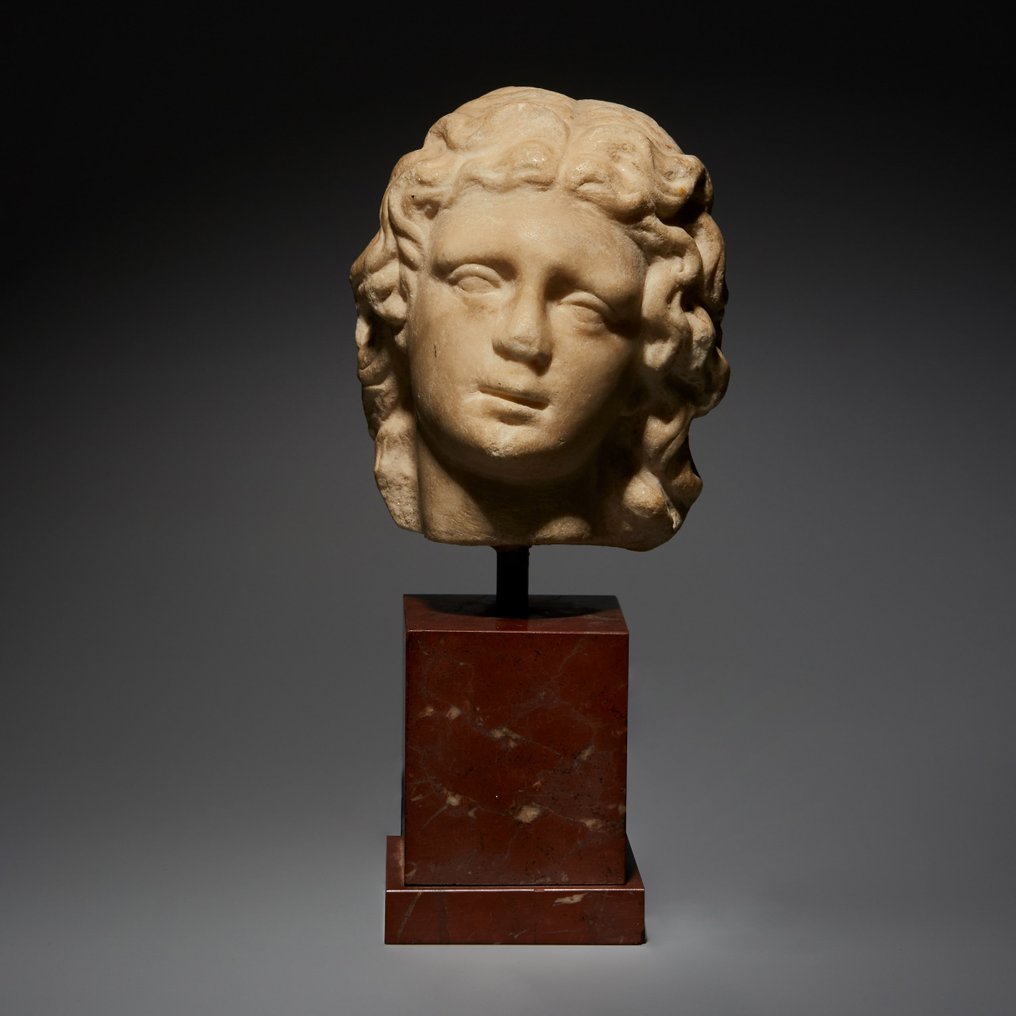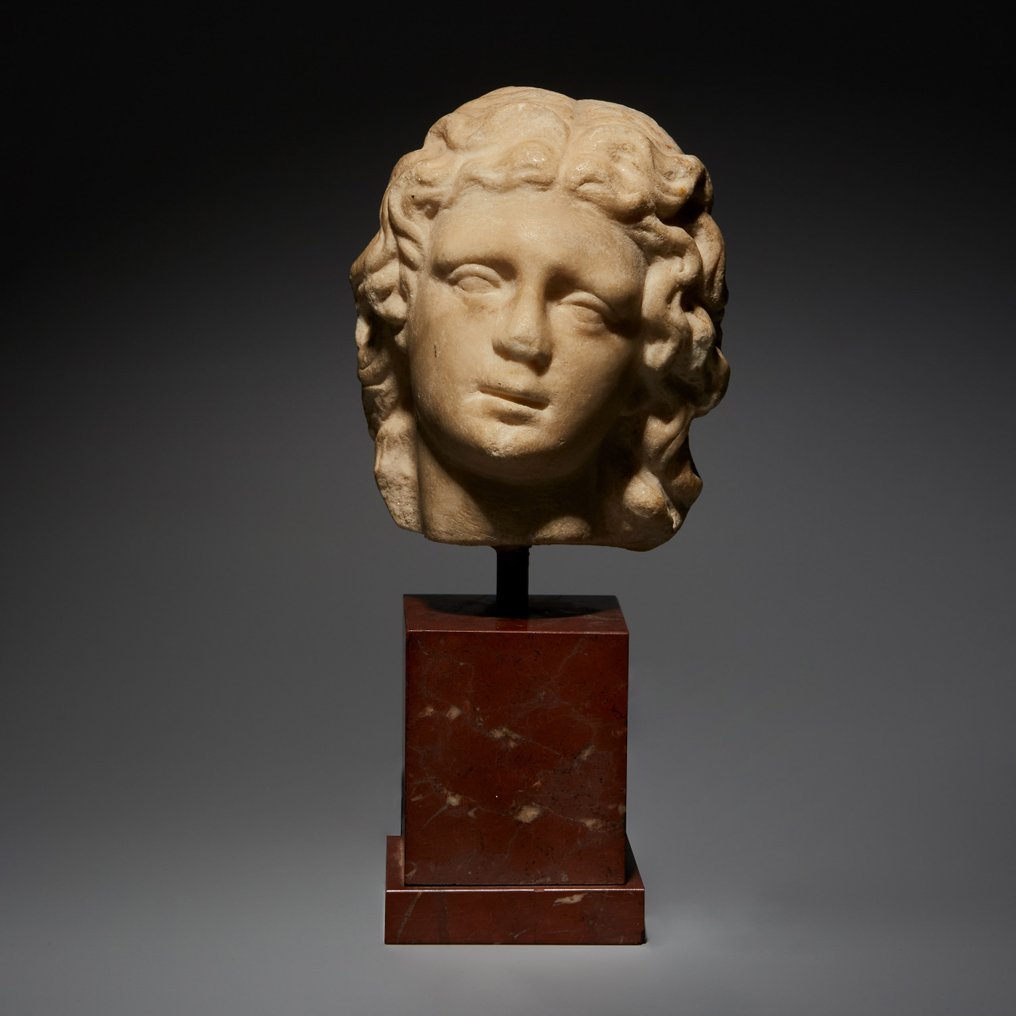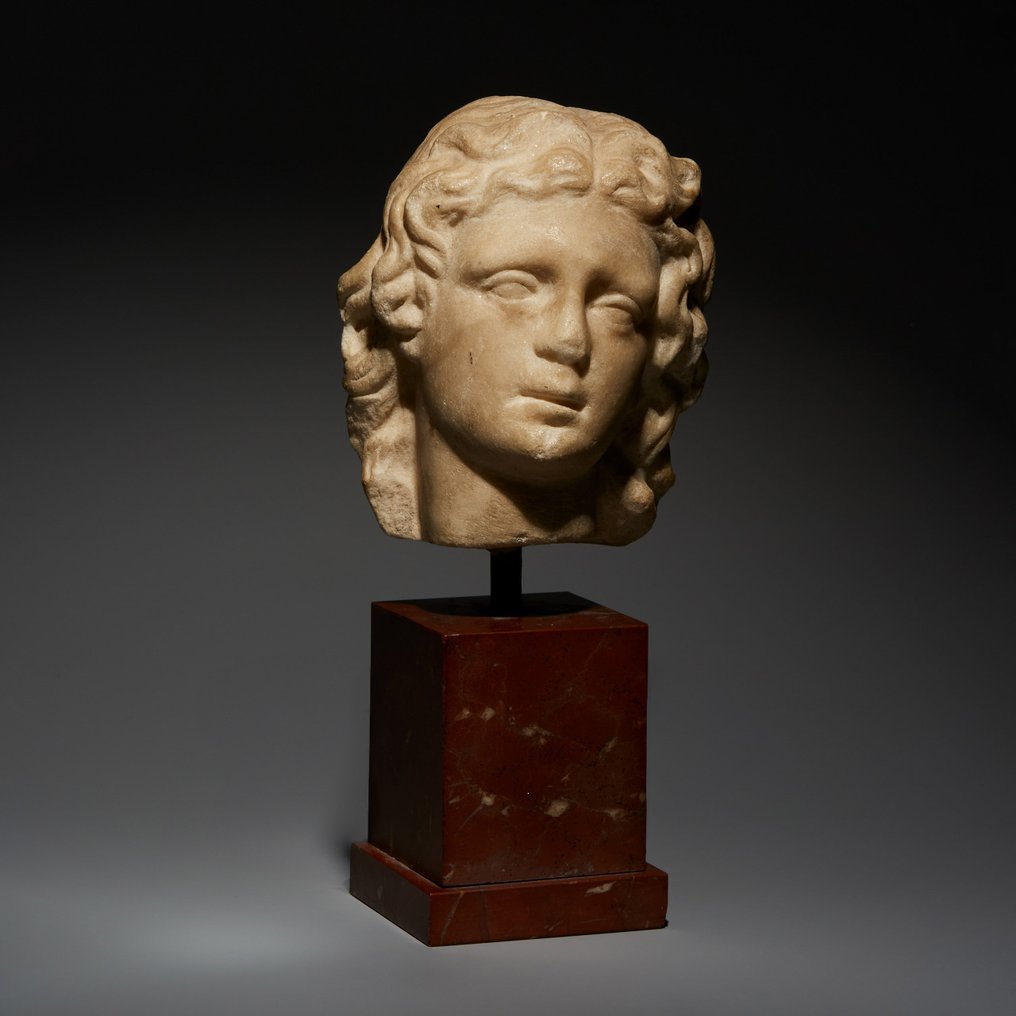Great object. Really beautiful. Quick delivery. Excellent.
Ver traducciónAntigua Roma Mármol Jefe Amazonas. Siglo I-II d.C. 11,5 cm de altura.
N.º 88172845



Amazon Head
Ancient Roman, 1st - 2nd century AD.
Marble.
11.5 cm height.
Condition: Good state of conservation, without restorations. There is a scratch on the chin and a slight missing piece of hair on the back right.
Provenance: Private collection, Doullens, France, 1970 – 1908.
Description:
Head carved in marble in a round shape belonging to a sculpture of less than life size, about 90 cm in total height. It represents a youthful female face that follows the iconography of the wounded Amazon, developed from the models that Polycletus, Phidias, Cresilas and two other unknown sculptors, Cydon and Phradmon, created for the temple of Artemis in Ephesus around 440 BC. (fig. 1). Having lost strength, the head tilts to the left, the thick-lidded eyes narrow and the mouth relaxes and opens slightly, evoking a panting breath. The elegant languor of the figure, its expressive restraint and the grace of gesture and movement reveal the influence of classical Greek models, especially current in Roman art of the 1st and 2nd centuries AD. In Naples, an Amazon head very similar in expression is preserved, derived directly from Greek models from the 5th century BC. (fig. 2).
The carving is delicate and precise, with a facial modeling that balances idealization and naturalism in its combination of fluid lines, delicately curved on the cheeks, jaw, chin and neck, and a gently frowning brow that provides a content but expressive drama to the representation, characteristic of the Greek models of the second half of the 5th century BC. The loose and wavy hair frames the face, providing a dynamic play of contrast of light and shadow, and is worked with thick independent strands, moved and volumetric around the face and flatter, although equally individualized, on the back of the head. head.
In Greek mythology, the Amazons were a race of warriors and hunters, daughters of Ares and worshipers of Artemis. They lived, literally and symbolically, on the margins of the human world. Located by ancient Greek legends in Asia Minor, the steppes around the Black Sea or even Libya, were conceived as the embodiment of the wild, the opposite of civilization. That is why they generally appear in mythical narratives as opponents of the Greeks: the Amazon queen Penthesilea faced Achilles in a duel during the Trojan War, and her sister, Hippolyta, fought against Hercules in one of his twelve labors. . The theme of the Amazonomachy, the battle between men and Amazons as a symbolic confrontation between civilization and barbarism, was a frequent iconographic theme in Greece and also in Rome; It appears in the Treasury of the Athenians at Delphi and on the altar of Zeus in Pergamon, although perhaps the most important example is the series of metopes that Phidias made for the Parthenon in Athens.
Brave, brave and fearsome, the Amazons carried out military expeditions to the most distant corners of the world, from Scythia to Egypt, and were also considered founders of temples and ancient cities such as Ephesus or Smyrna. They had no relationship with men other than what was strictly necessary to reproduce, and they raised only the girls, returning the boys to their fathers. The discovery of tombs of warrior women in the Eurasian steppe suggests that the myth of the Amazons could be based on the encounters of the Greeks with queens and warriors of the nomadic horsemen people of the area - Scythians, Sarmatians and Hittites.
Bibliography:
- BOTHMER, D. von. Amazons in Greek Art. Oxford University Press. 1957.
- GRIMAL, P. The Dictionary of Classical Mythology. Wiley-Blackwell. nineteen ninety six.
- KLEINER, D.E. Roman Sculpture. Yale University Press. 1992.
Parallels:
Fig. 1 Wounded Amazon. Roman copy of the s. I AD from a Greek original from the 19th century. V BC Marble, 195 cm high. Ny Carlsberg Glyptotek, Copenhagen, inv. 1658.
Fig. 2 Wounded Amazon head. Roman copy of the s. I AD from a Greek original from the 19th century. V BC Marble, 31 cm high. Museo Archeologico Nazionale di Napoli (Italy), inv. 15041.
Notes:
The piece includes authenticity certificate.
The piece includes Spanish Export License.
El vendedor y su historia
Amazon Head
Ancient Roman, 1st - 2nd century AD.
Marble.
11.5 cm height.
Condition: Good state of conservation, without restorations. There is a scratch on the chin and a slight missing piece of hair on the back right.
Provenance: Private collection, Doullens, France, 1970 – 1908.
Description:
Head carved in marble in a round shape belonging to a sculpture of less than life size, about 90 cm in total height. It represents a youthful female face that follows the iconography of the wounded Amazon, developed from the models that Polycletus, Phidias, Cresilas and two other unknown sculptors, Cydon and Phradmon, created for the temple of Artemis in Ephesus around 440 BC. (fig. 1). Having lost strength, the head tilts to the left, the thick-lidded eyes narrow and the mouth relaxes and opens slightly, evoking a panting breath. The elegant languor of the figure, its expressive restraint and the grace of gesture and movement reveal the influence of classical Greek models, especially current in Roman art of the 1st and 2nd centuries AD. In Naples, an Amazon head very similar in expression is preserved, derived directly from Greek models from the 5th century BC. (fig. 2).
The carving is delicate and precise, with a facial modeling that balances idealization and naturalism in its combination of fluid lines, delicately curved on the cheeks, jaw, chin and neck, and a gently frowning brow that provides a content but expressive drama to the representation, characteristic of the Greek models of the second half of the 5th century BC. The loose and wavy hair frames the face, providing a dynamic play of contrast of light and shadow, and is worked with thick independent strands, moved and volumetric around the face and flatter, although equally individualized, on the back of the head. head.
In Greek mythology, the Amazons were a race of warriors and hunters, daughters of Ares and worshipers of Artemis. They lived, literally and symbolically, on the margins of the human world. Located by ancient Greek legends in Asia Minor, the steppes around the Black Sea or even Libya, were conceived as the embodiment of the wild, the opposite of civilization. That is why they generally appear in mythical narratives as opponents of the Greeks: the Amazon queen Penthesilea faced Achilles in a duel during the Trojan War, and her sister, Hippolyta, fought against Hercules in one of his twelve labors. . The theme of the Amazonomachy, the battle between men and Amazons as a symbolic confrontation between civilization and barbarism, was a frequent iconographic theme in Greece and also in Rome; It appears in the Treasury of the Athenians at Delphi and on the altar of Zeus in Pergamon, although perhaps the most important example is the series of metopes that Phidias made for the Parthenon in Athens.
Brave, brave and fearsome, the Amazons carried out military expeditions to the most distant corners of the world, from Scythia to Egypt, and were also considered founders of temples and ancient cities such as Ephesus or Smyrna. They had no relationship with men other than what was strictly necessary to reproduce, and they raised only the girls, returning the boys to their fathers. The discovery of tombs of warrior women in the Eurasian steppe suggests that the myth of the Amazons could be based on the encounters of the Greeks with queens and warriors of the nomadic horsemen people of the area - Scythians, Sarmatians and Hittites.
Bibliography:
- BOTHMER, D. von. Amazons in Greek Art. Oxford University Press. 1957.
- GRIMAL, P. The Dictionary of Classical Mythology. Wiley-Blackwell. nineteen ninety six.
- KLEINER, D.E. Roman Sculpture. Yale University Press. 1992.
Parallels:
Fig. 1 Wounded Amazon. Roman copy of the s. I AD from a Greek original from the 19th century. V BC Marble, 195 cm high. Ny Carlsberg Glyptotek, Copenhagen, inv. 1658.
Fig. 2 Wounded Amazon head. Roman copy of the s. I AD from a Greek original from the 19th century. V BC Marble, 31 cm high. Museo Archeologico Nazionale di Napoli (Italy), inv. 15041.
Notes:
The piece includes authenticity certificate.
The piece includes Spanish Export License.
El vendedor y su historia
- 823
- 11
- 1
Superbe objet, Service d'Arqueologia Ancient Art excellent et rapide. Jaume Bagot toujours parfait .
Ver traducciónTodo perfecto gracias
Ver traducciónNice item all ok A+++
Ver traducciónThank you for this Oinochoe, one question: did you as promised read my post!
Ver traducciónExcellent translation, and very prompt delivery. Imperfect packaging. A significant crack of the board that had not been described in the original post of the item.
Ver traducciónAlways a great pleasure!
Ver traducciónFine quality, good service. Thanks.
Ver traducciónMuy amables, muy bien todo. Gracias
Ver traducciónAlles bestens
Ver traducciónexactly as described and shipped safely and punctually.
Ver traducciónschnelle Lieferung sehr sichere Verpackung alles bestens
Ver traduccióntres bel objet je le recherchai depuis longtemps envoi rapide et protégé je pense qu'il y aura d'autres achats avec ce vendeur merci +++++++
Ver traducciónEinfach nur toll
Ver traducciónTodo perfecto
Ver traducciónottimo
Ver traducciónperfetto
Ver traduccióntop oggetto bellissimo grazie 💯💯💯💯💯💯 :-)
Ver traducciónI bought this beautiful artifact together with artifact from Mr. Bagot but although it is clearly stated on his shipping page that when purchasing multiple artifacts i paid the double package costs
Ver traducciónI bought this beautiful artifact together with artifact from Mr. Bagot but although it is clearly stated on his shipping page that when purchasing multiple artifacts i paid the double package costs
Ver traducciónBel objet, bien emballé. Parfait.
Ver traducciónwonderful faiece and very fast shipping.thanks a lot
Ver traducciónJ Bagot es un profesional excelente. Sus artículos son de gran calidad, se incluye la documentación necesaria y el embalaje se realiza con esmero. Le recomiendo encarecidamente.
Ver traduccióno envio foi bastante rápido, obrigado.
Ver traducciónSono molto soddisfatto grazie.
Ver traducción- 823
- 11
- 1
Great object. Really beautiful. Quick delivery. Excellent.
Ver traducciónAviso legal
El vendedor garantiza y puede probar que el objeto ha sido obtenido legalmente. Catawiki ha informado al vendedor de que tenía que proporcionar la documentación exigida por las leyes y reglamentos de su país de residencia. El vendedor garantiza que tiene derecho a vender/exportar este objeto. El vendedor le proporcionará al comprador toda la información disponible sobre la procedencia del objeto. El vendedor garantiza que se tramitarán todos los permisos necesarios. El vendedor informará inmediatamente al comprador de cualquier retraso en la obtención de dichos permisos.
El vendedor garantiza y puede probar que el objeto ha sido obtenido legalmente. Catawiki ha informado al vendedor de que tenía que proporcionar la documentación exigida por las leyes y reglamentos de su país de residencia. El vendedor garantiza que tiene derecho a vender/exportar este objeto. El vendedor le proporcionará al comprador toda la información disponible sobre la procedencia del objeto. El vendedor garantiza que se tramitarán todos los permisos necesarios. El vendedor informará inmediatamente al comprador de cualquier retraso en la obtención de dichos permisos.









